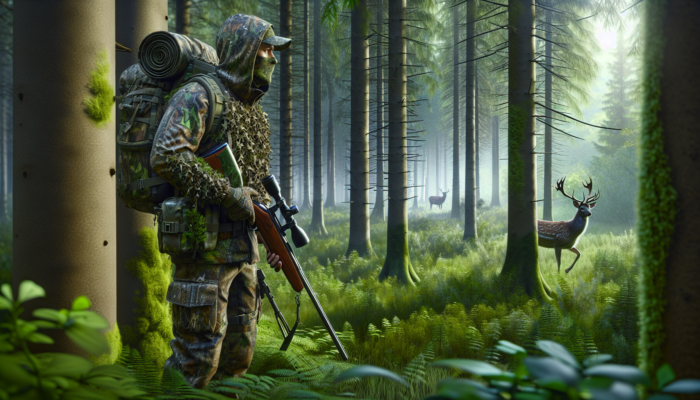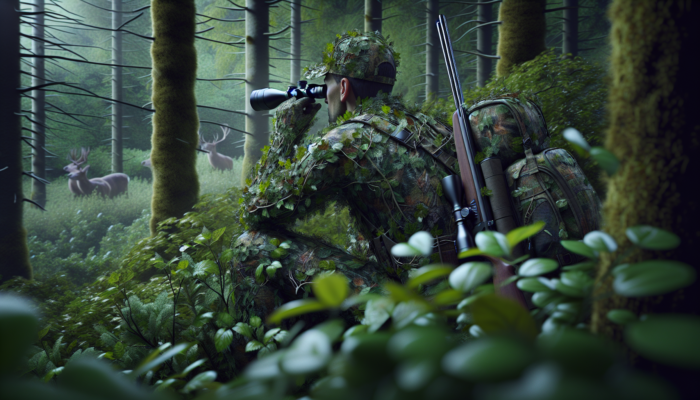Enhance Your Silent Hunting Skills by Mastering Stealth Techniques
Understanding How Stealth Plays a Vital Role in Successful Hunting

Achieving mastery in stealth is essential for anyone dedicated to becoming an effective hunter. The capacity to approach your chosen game without attracting attention markedly increases your chances of a successful hunt. Wildlife possesses sharp senses, including sight, smell, and hearing, finely tuned to detect any human presence. As a passionate hunter, your main goal is to remain inconspicuous, allowing you to close the distance to your target and execute your shot with accuracy. The ongoing struggle between predator and prey creates a dynamic environment, making the refinement of your <a href="https://limitsofstrategy.com/hunting-for-beginners-your-essential-starter-guide/">hunting stealth techniques</a> crucial. Attaining this skill set elevates you from being a mere participant to a strategic predator, significantly enhancing your overall hunting effectiveness.
Furthermore, the psychological aspect of stealth is paramount for your hunting success. A composed and unobtrusive presence not only boosts your chances of a successful hunt but also enriches the enjoyment of your experiences in nature. By moving quietly and blending seamlessly with your surroundings, you gain the opportunity to closely observe wildlife behaviors, offering valuable insights that can influence your future hunting strategies. Additionally, respecting wildlife and their habitats is a fundamental principle of ethical hunting practices, making the development of stealth skills indispensable for conscientious hunters.
Proven Techniques for Stealthy Movement During Hunting
To attain excellence in hunting stealth techniques, grasping the fundamentals of quiet movement is crucial. A key aspect involves foot placement; aim to step on softer ground, such as grass or fallen leaves, instead of harder surfaces that can create noise. Practicing the whisper step technique—placing your heel down first and then gently rolling your foot forward—can drastically reduce noise levels as you traverse your hunting terrain. Mastering this skill will not only enhance your stealth but also increase your chances of a successful hunt.
Moreover, being conscious of the terrain is vital. Different environments present unique challenges and opportunities. For instance, when navigating a forest, utilize fallen leaves and branches to soften your footfalls and minimize noise. Conversely, while crossing rocky terrain, proceed slowly and with intent, as the sound of shifting stones can easily alert nearby wildlife. Maintaining a low profile is equally essential; keeping your body close to the ground helps you blend into various backgrounds and reduces the risk of being detected by your target.
Additionally, breath control is an often-overlooked element of stealth. Quick, shallow breaths can produce unnecessary noise, especially when you are in close proximity to your game. Practicing deep, controlled breathing can assist in managing anxiety and maintaining focus, ensuring you remain calm during high-stakes moments in the field. By mastering these techniques, you’ll not only improve your stealth but also enhance your overall hunting experience.
Enhance Your Stealth Through Effective Camouflage Techniques
Employing effective camouflage is vital for improving your hunting stealth techniques. The right gear enables you to blend into your environment effortlessly, thereby diminishing the likelihood of being detected by your target. This requires selecting clothing that matches the colors and patterns of your hunting surroundings—earthy tones for woodland areas and lighter shades for more open fields. By doing so, you create a visual barrier that helps you stay concealed from wildlife.
Furthermore, the material of your clothing significantly impacts your stealth effectiveness. Choose soft fabrics that absorb sound rather than reflect it, as this is essential for maintaining silence while moving. Additionally, consider integrating scent-masking fabrics that neutralize human odors, further decreasing the chances of alerting the game to your presence. This attention to detail can elevate your overall hunting success.
Investing in a high-quality ghillie suit can further improve your concealment efforts. These suits are specifically designed to break up your outline and mimic natural elements in your environment, making it increasingly difficult for animals to ascertain your exact location. However, while effective camouflage is critical, it must be complemented with movement techniques and situational awareness to maximize its overall effectiveness in the field.
Sharpen Your Senses to Enhance Your Stealth Hunting Skills

Developing heightened sensory perception is crucial for achieving success in stealth hunting. Actively listening and observing your surroundings can greatly improve your hunting outcomes. Begin by participating in active listening exercises in tranquil environments. Focus on distinguishing subtle sounds—such as the rustling of leaves, snapping of twigs, or distant animal calls. This practice will enable you to detect the presence of animals before they come into view, providing you with a significant advantage.
Your visual acuity can also be enhanced through dedicated training. Spend time observing wildlife and their behaviors, paying close attention to their reactions to various stimuli. This keen observation can yield valuable insights into their movement patterns, allowing you to anticipate their actions and plan your approach accordingly. Such knowledge will undoubtedly improve your effectiveness as a hunter.
In addition, training your sense of smell is essential for grasping how animals perceive their environment. Familiarize yourself with the scents of various species and learn techniques to mask your own scent. Simple exercises, such as identifying different natural scents in your surroundings, can enhance your olfactory senses, allowing you to become more attuned to the nuances of nature. This holistic approach to sensory training can significantly elevate your stealth hunting skills.
Advanced Strategies for Perfecting Stealth in Hunting
Master the Skill of Stalking Your Prey with Precision
Stalking is a complex skill that forms a core component of hunting stealth techniques. This intricate art demands attention to foot placement, body control, and environmental awareness. To become an efficient stalker, prioritize your footfalls—softly placing your foot down and leveraging the terrain to your advantage. Soft surfaces, such as moss or grass, create an ideal environment for silent movement, enabling you to approach your target undetected.
Practicing body control is equally vital. Keep your body low and your movements fluid to avoid generating unnecessary noise that could alert your prey. Use your arms for balance and stability while avoiding sudden movements that might startle nearby animals. Consistency is key; maintaining a slow and steady pace lowers the risk of errors, while a hurried approach can jeopardize your chances of success. Take your time and remain patient to improve your stalking ability.
Learning to interpret animal tracks and signs can also elevate your stalking proficiency. Familiarize yourself with the habitats of your target species by observing their feeding and bedding areas. This knowledge empowers you to anticipate their movements, allowing you to position yourself advantageously for a successful hunt. By honing this skill, you’ll become a more formidable competitor in the field.
Utilizing Terrain to Gain Stealth Advantages During Hunting

The natural landscape can serve as a powerful ally in your quest for stealth. Understanding how to effectively leverage the terrain can help obscure your presence and enhance your movements. For example, consider using natural cover like trees, shrubs, or rocks as shields when approaching areas where you suspect game may be present. This strategic utilization of the environment can significantly improve your chances of success.
Elevation can also provide a strategic advantage. Positioning yourself higher up, whether in a tree stand or on a ridge, offers a broader perspective of the landscape while keeping you hidden from below. Furthermore, navigating along natural features such as valleys or ridges can help you avoid open areas, where you may be more vulnerable to detection. These insights can help you remain undetected while increasing your effectiveness.
Wind direction is another critical factor to consider during your approach. Always be mindful of the wind’s trajectory; approaching from downwind ensures that your scent does not alert the game. Similarly, utilizing the terrain to create wind barriers can further enhance your stealth capabilities, allowing you to move closer to your target without raising suspicion.
Adjusting Stealth Techniques to Different Weather Conditions
Weather conditions can significantly impact your hunting stealth techniques. Adapting your strategies according to environmental factors is crucial for maintaining efficiency in the field. For instance, rain can muffle sounds, enabling quieter movement, but it can also create muddy terrain that generates noise. Being aware of these nuances allows you to adjust your approach accordingly.
In windy conditions, take advantage of the wind by moving against it to disguise your scent. However, be cautious that strong winds can carry sounds, so modify your pace and volume as necessary. Visibility may also be limited for both you and the game during foggy or overcast conditions, presenting a unique opportunity for a closer approach than usual. Being adaptable in varying weather scenarios is essential for a successful hunting experience.
Understanding animal behavior under different weather conditions is equally important. Many species may exhibit increased activity during specific weather, allowing you to tailor your strategy based on their expected behaviors. This knowledge will enable you to make informed decisions and improve your chances of a successful hunt.
The Psychological Factors Influencing Success in Stealth Hunting
The mental discipline required for successful stealth hunting is often underestimated. Maintaining focus and composure is crucial; even the slightest distraction can lead to detection. Establishing a strong mental framework can be as critical as mastering physical skills in the field.
Before you embark on a hunt, mentally prepare by visualizing your approach and envisioning successful outcomes. This mental rehearsal can bolster your confidence and help you maintain calmness in the field. Additionally, adopting a patient mindset is essential. Stealth hunting often necessitates prolonged periods of waiting and observing, which can test your resolve and patience.
Practicing mindfulness techniques can enhance your concentration and awareness of your environment. This heightened awareness allows you to detect subtle changes in your surroundings, such as shifts in animal behavior or unexpected sounds. Ultimately, the psychological aspects of stealth hunting can significantly enhance your performance and success rates in the field.
Essential Gear and Tools for the Silent Hunter
Investing in Top-Quality Equipment for Maximum Stealth Efficiency
Investing in essential gear is critical for optimizing your performance in stealth hunting. A well-fitted camouflage outfit forms the foundation of your stealth equipment. Seek clothing that balances comfort, durability, and sound-dampening properties for optimal results. Quality gear can make all the difference in your ability to remain hidden from your target.
Footwear is another vital component of your stealth setup. Choose boots that provide both support and noise reduction. Soft-soled boots are ideal for stealth, enabling quiet movement across various terrains. Additionally, consider wearing gaiters to protect your legs and minimize noise from brush or undergrowth. This attention to detail can substantially enhance your stealth capabilities.
Other crucial pieces of equipment include a silent backpack for transporting gear, binoculars for scouting, and a reliable hunting knife. Each item should be carefully selected to boost your stealth abilities, ensuring that you remain undetected while pursuing your target. By investing in the right tools, you set yourself up for success in the field.
Innovative Technologies Enhancing Stealth Hunting Capabilities
As the hunting landscape continues to evolve, so do the technologies available to hunters. Cutting-edge gear designed for stealth can significantly enhance your experience in the field. For example, sound-dampening fabrics and materials are now commonly integrated into hunting clothing, allowing for quieter movements that are less likely to alert wildlife.
Modern camouflage options also feature advanced patterns and materials that closely replicate natural environments. Additionally, some manufacturers offer scent-masking technologies that neutralize human odors, greatly increasing your chances of remaining undetected in the field. Such innovations are game-changers for serious hunters looking to improve their stealth.
High-quality optics have also seen significant advancements, enabling hunters to spot game from greater distances without revealing their positions. These technological innovations not only enhance stealth but also improve the overall success rates of hunting endeavors, making them essential for any serious hunter.
Maintaining Your Stealth Equipment for Longevity and Optimal Performance
Proper maintenance of your stealth gear is essential for ensuring its long-term effectiveness. Regular cleaning of your camouflage clothing is crucial; dirt and grime can diminish its effectiveness, making you more visible to your target. Be sure to follow the manufacturer’s care instructions to maintain the integrity of the materials and ensure your gear remains functional.
Moreover, routinely inspect your footwear for signs of wear and tear. A damaged sole or upper can hamper your ability to move silently through various terrains. Treat leather boots with waterproofing agents to prolong their lifespan and maintain comfort during your hunts. This proactive approach can drastically improve your performance in the field.
Your hunting accessories, including binoculars and knives, should also be adequately maintained. Regularly cleaning and sharpening your knife ensures optimal performance, while careful storage of optical devices protects against scratches or damage. By diligently caring for your equipment, you enhance your stealth capabilities and overall hunting experience.
Budget-Friendly Solutions for Effective Stealth Hunting
Not every hunter can afford high-end gear, yet effective hunting stealth techniques can still be achieved through budget-friendly options. Start by utilizing what you already possess—dark, muted clothing can be just as effective if it blends well with your surroundings. This resourcefulness can help you maintain a stealthy presence without breaking the bank.
Consider DIY camouflage solutions, such as using natural materials like leaves and branches to create cover. This approach not only saves money but also fosters a deeper connection with your environment and enhances your hunting experience. Creativity can be your ally in achieving effective stealth.
Moreover, prioritize acquiring essential items that offer the most significant benefits, such as quality footwear and accessories. Investing in a few key pieces rather than a complete set of high-end gear can help you maintain effective stealth without straining your budget. This strategic approach can lead to success in the field.
Practical Applications of Stealth Techniques in Real Hunting Situations
Customizing Stealth Hunting Techniques Based on Different Game Species
Tailoring your stealth approach according to the behaviors and senses of various animals is critical for hunting success. Each species possesses unique characteristics that influence how you should pursue them. For instance, deer have exceptional eyesight and are incredibly alert, requiring a more cautious approach with careful attention to movement and wind direction. Adapting your methods is vital for a successful outcome.
Predators such as foxes or coyotes rely heavily on their sense of smell, making scent control paramount during hunting. Utilizing scent-masking products and remaining conscious of your movements can significantly enhance your chances of success when hunting these species. Understanding these nuances will elevate your effectiveness as a hunter.
Familiarizing yourself with the habitat and behaviors of your target species allows you to develop a specific stealth strategy that maximizes your likelihood of a successful hunt. This adaptability is a hallmark of skilled hunters and is vital for achieving effectiveness in the field.
Illustrative Case Studies Highlighting Successful Stealth Hunts
Real-life examples of successful hunting stealth techniques can offer invaluable insights for aspiring hunters. One notable case involved a hunter successfully stalking a herd of elk. By employing natural cover and remaining downwind, the hunter could observe the herd for an extended period before taking a well-placed shot, demonstrating the power of patience and strategy.
Another example features a hunter’s experience in a dense forest. This hunter remained undetected by moving slowly and deliberately, utilizing terrain features, and closely observing animal behavior, which ultimately led to a successful outcome. These instances emphasize the importance of patience, observation, and adaptability in stealth hunting.
Learning from the experiences of others can help refine your techniques and strategies in the field, making these case studies a valuable resource for hunters looking to improve their stealth abilities.
Applying Stealth Hunting Techniques in Urban and Suburban Environments
Adapting hunting stealth techniques for urban and suburban settings presents distinct challenges. Noise and human activity can complicate stealth approaches, but success is still attainable with careful planning and execution. By understanding the unique dynamics of these environments, you can tailor your strategies for effective hunting.
Timing is crucial when hunting in these regions. Early mornings or late evenings often provide optimal conditions, with increased animal activity as human presence wanes. Utilize natural cover, such as hedges or fences, to camouflage your movements during these times, enhancing your chances of a successful hunt.
Understanding local regulations is also essential. To avoid complications, ensure your hunting activities comply with laws and guidelines. By modifying your strategies to fit the urban landscape, you can maintain effective stealth while being ethical and responsible in your hunting practices.
Ethical Considerations and Regulations in Stealth Hunting Practices
Responsible hunters must grasp the legal and ethical considerations surrounding hunting stealth techniques. Ethical hunting practices promote sustainability and wildlife conservation. Always stay informed about local laws concerning hunting seasons, permissible areas, and species regulations to ensure responsible hunting practices.
Respecting the animal and its environment is of utmost importance. Avoid hunting practices that could lead to unnecessary suffering or jeopardize local populations. Embracing patience, restraint, and a commitment to ethical approaches enhances the overall hunting experience and fosters a responsible hunting culture.
Engaging with local hunting communities can provide valuable insights into responsible practices and regulations. Sharing knowledge and experiences aids in cultivating a culture of ethical hunting, ensuring wildlife preservation for future generations. This commitment to ethics enriches the hunting community as a whole.
Developing Skills and Training for Mastery in Stealth Hunting
Participating in Workshops and Courses for Mastering Stealth Hunting Techniques
To elevate your hunting stealth techniques, engaging in workshops and courses can provide invaluable education and hands-on experience. Numerous outdoor organizations offer specialized training focused on stealth and advanced hunting strategies, helping participants hone their skills effectively.
These programs often include practical field exercises, allowing attendees to practice techniques in real-world scenarios. Learning from experienced instructors can accelerate your skill development and offer insights that might not be available through self-study. This immersive approach enhances your learning experience significantly.
Additionally, attending hunting expos and seminars can connect you with industry experts and fellow hunters, fostering a community of shared knowledge and resources that benefits all participants. These connections can be invaluable for your growth as a stealth hunter.
Practicing Stealth Techniques at Home to Enhance Your Skills
Improving your stealth capabilities doesn’t require a hunting trip; you can practice techniques at home. Simple exercises like walking quietly on different surfaces can help you become more aware of your foot placement and overall movement, providing a solid foundation for your skills.
Incorporate drills focusing on breath control and patience, such as remaining still and quiet while observing your surroundings. This exercise enhances your ability to remain undetected in the field, allowing you to develop your stealth skills in a controlled environment.
Mindfulness practices can also sharpen your awareness and focus, which are essential for effective stealth hunting. By dedicating time to practice at home, you can build a strong foundation for future success when you venture into the field.
Learning from Experienced Stealth Hunters Through Mentorship
Seeking mentorship from seasoned hunters can significantly accelerate your learning curve in hunting stealth techniques. Experienced hunters often possess a wealth of knowledge and insights that can prove invaluable to novices, offering guidance that can enhance your skills immensely.
Consider joining local hunting clubs or participating in guided hunts where you can learn from those with more experience. Observing their techniques and asking questions can provide practical knowledge that enhances your abilities. This form of experiential learning can be transformative.
Moreover, building relationships with fellow hunters can create opportunities for collaboration and shared experiences, fostering a supportive hunting community that encourages continuous learning and improvement. Such connections can be invaluable for your growth and success as a stealth hunter.
Evaluating Your Progress in Stealth Hunting Skills
Establish a self-assessment system to measure and track your improvement in stealth hunting. Keeping a journal can be beneficial for documenting your experiences, techniques, and outcomes during hunts. Reflecting on these experiences can highlight areas for improvement and reinforce successful strategies, setting you on a path of continuous growth.
Additionally, seeking feedback from peers or mentors can provide valuable insights into your progress. Constructive criticism can guide you in refining your techniques and developing a more effective stealth approach. This feedback loop can be instrumental in your development as a hunter.
Regularly revisiting your goals and adjusting your training methods can further enhance your development as a stealth hunter. Committing to continuous improvement can elevate your skills and increase your success in the field.
Overcoming Common Challenges in Stealth Hunting
Strategies for Successfully Navigating Noisy Terrain While Hunting
Maintaining stealth in noisy terrain can pose significant challenges for hunters. However, with the right strategies, you can effectively navigate these environments. First, adjust your movements to mimic the natural sounds of the terrain. For instance, if walking on gravel, move in a way that blends with the sound of shifting stones, thereby minimizing your detectability.
Additionally, consider the timing of your approach. Hunting during inclement weather, such as rain or wind, can mask your movements and facilitate quieter passage through the area. Furthermore, taking slow, deliberate steps helps to reduce noise, allowing you to maintain stealth effectively.
Utilizing natural cover, such as bushes or trees, can also help conceal your presence from nearby game. By employing these strategies, you can navigate noisy environments successfully while remaining undetected, ensuring a more successful hunting experience.
Managing Wind Direction and Scent Control for Optimal Stealth Success
Wind direction plays a pivotal role in your hunting stealth techniques. Understanding how to manage your scent is critical for successful stealth hunting. Always approach your target from downwind, allowing the wind to carry your scent away from the game you are pursuing. This basic principle is fundamental for maintaining a stealthy approach.
Utilizing scent-masking products, such as sprays or scent-free clothing, can minimize your scent signature. Additionally, maintaining good hygiene before a hunt—such as showering with unscented soap and avoiding heavily scented products—can further reduce the likelihood of detection. This attention to detail can significantly enhance your stealth capabilities.
Regularly monitor wind shifts during your hunt. Adjust your approach as the wind direction changes, ensuring that you remain undetected throughout your pursuit. This adaptability is essential for successful stealth hunting.
Minimizing Human Error in Stealth Hunting Scenarios
Human error is inevitable in any hunting experience but can be minimized through careful planning and awareness. Common mistakes, such as sudden movements or loud noises, can alert the game and jeopardize your stealth. Being conscious of these factors is crucial for a successful hunt.
To combat this, practice mindfulness and focus on your movements. Before starting your hunt, take a moment to prepare and mentally visualize your approach. This mental rehearsal can help you remain composed and deliberate in your actions, reducing the likelihood of making errors.
Additionally, learn from past mistakes by maintaining a hunting journal. Reflect on what occurred during previous hunts and develop strategies to avoid repeating those errors. This self-awareness will enhance your overall effectiveness in the field, allowing you to improve continuously.
Adapting to Unexpected Situations While Stealth Hunting
Unexpected challenges can arise during a hunt, and the ability to adapt is vital for maintaining stealth. Flexibility is essential, whether it’s a sudden noise, an unanticipated change in wind direction, or encountering other hunters. Being prepared for the unexpected can make a significant difference in your hunting success.
Stay calm and assess the situation before making decisions. If you encounter unexpected noise, pause and observe to determine its source. This moment of stillness can provide valuable insight into whether to proceed or modify your approach, allowing you to maintain your stealth in the face of challenges.
Moreover, developing various strategies for different scenarios can enhance your adaptability. Practicing diverse techniques in various environments equips you to respond effectively to changing circumstances, ensuring your continued success in stealth hunting.
The Future of Stealth Hunting Techniques
Emerging Trends Influencing the Future of Stealth Hunting
The landscape of hunting stealth techniques is constantly evolving, with emerging trends impacting the future of silent hunting. One significant trend is the growing focus on sustainability and ethical practices. Today’s hunters are increasingly aware of their environmental impact, leading to a shift toward methods that prioritize conservation and responsible hunting.
Additionally, technological advancements are paving the way for innovative gear and equipment that enhance stealth capabilities. From sound-dampening materials to advanced camouflage patterns, these innovations are transforming the hunting experience for enthusiasts, making it more efficient and effective.
Furthermore, the rise of social media and online communities has fostered a culture of knowledge-sharing among hunters. This interconnectedness facilitates the exchange of ideas and techniques, further advancing the practice of stealth hunting and ensuring that best practices are disseminated widely.
The Impact of Technology on Stealth Hunting Techniques
Modern technologies are significantly influencing the development and application of hunting stealth techniques. For example, mobile applications providing real-time weather updates and wind direction forecasts can help hunters plan their approaches more effectively, enhancing overall stealth efforts.
Wearable technology like fitness trackers can monitor physical performance and enhance stealth movements. This data-driven approach enables hunters to assess their stamina and efficiency in the field, ultimately improving their overall hunting effectiveness.
Moreover, advancements in optics and camera technology have revolutionized how hunters scout and observe game. High-definition binoculars and trail cameras provide unprecedented insights into animal behavior, allowing for more strategic planning and execution during hunts. These innovations are essential for modern hunters looking to maximize their success.
Stealth Hunting and Sustainability: A Growing Connection
The role of stealth hunting in sustainable wildlife management is gaining increasing recognition. Ethical hunting practices contribute to population control and habitat preservation, which are critical for the overall health of ecosystems. Understanding this connection enhances the value of stealth hunting techniques.
Stealth hunting techniques facilitate more selective harvesting, minimizing the impact on animal populations. By exercising patience and restraint, hunters can ensure they only take what is necessary, aligning their activities with conservation goals. This mindful approach enriches the hunting experience and fosters a sense of responsibility.
Engaging in community-based conservation initiatives can also enhance the sustainability of hunting practices. Collaborating with local organizations to promote ethical hunting can positively impact wildlife populations and habitats, ensuring that future generations can enjoy the outdoors.
Anticipating the Evolution of Stealth Hunting Practices
As the hunting landscape changes, anticipating the future of hunting stealth techniques involves considering various factors. Environmental changes, technological advancements, and evolving cultural attitudes toward hunting will all shape future practices. This foresight is crucial for staying ahead in the field.
Expect the integration of more sophisticated gear, such as augmented reality for scouting and tracking, which can enhance the hunting experience while preserving stealth. Additionally, an increased focus on conservation and ethical practices will likely influence hunting methods, promoting more responsible and sustainable approaches.
Ultimately, the evolution of stealth hunting practices will reflect a blend of tradition and innovation, ensuring that hunters continue to engage with the natural world in a respectful and effective manner, preserving the art of hunting for years to come.
Frequently Asked Questions About Stealth Hunting Techniques
What are the essential components of stealth in hunting?
Key components include silent movement, effective camouflage, sensory awareness, and a comprehensive understanding of animal behavior. These factors are essential for a hunter to remain undetected while pursuing game successfully.
How can I improve my stealth movement?
Focus on foot placement, slow and deliberate movements, and body control. Practicing exercises that emphasize quiet movement across various terrains can significantly enhance your stealth abilities and effectiveness.
What is the significance of camouflage in stealth hunting?
Camouflage enables hunters to blend into their surroundings, thereby reducing the game’s visibility. Properly selected clothing and materials are crucial for maximizing concealment and minimizing detection.
How can I train my senses for stealth hunting?
Engage in active listening exercises, observe wildlife behavior, and practice scent recognition. These activities sharpen your awareness and enhance your ability to remain undetected in the field.
What are some advanced stalking techniques?
Advanced stalking techniques include careful foot placement, utilizing natural cover, and understanding animal behavior. Practicing these methods can significantly improve your ability to approach game quietly and effectively.
How can I adjust my hunting techniques based on weather conditions?
Modify your approach according to weather—leverage rain to mask sounds, adapt to wind direction, and learn how animals behave differently in various scenarios. Flexibility is key to maintaining stealth in changing conditions.
What essential gear should I have for stealth hunting?
Essential gear includes a well-fitted camouflage outfit, silent footwear, a quality hunting knife, and accessories like binoculars. Each item should enhance your stealth capabilities and contribute to a successful hunting experience.
How can I effectively maintain my stealth equipment?
Regular cleaning and proper care of your gear are crucial for maintaining its effectiveness. Adhere to manufacturer instructions for washing, storing, and inspecting your equipment to ensure longevity and performance.
What ethical considerations should I keep in mind while stealth hunting?
Always follow local regulations, prioritize sustainability, and respect wildlife. Ethical practices ensure responsible hunting and contribute to the preservation of ecosystems for future generations.
How can I track my progress in stealth hunting?
Maintain a journal to document your experiences, techniques, and outcomes. Seek feedback from peers or mentors to evaluate your skills and make necessary adjustments for improvement.
Explore our world on X!
The post Hunting Stealth Techniques for Mastering Silent Hunting appeared first on Survival Bite.
The Article Stealth Techniques for Mastering Silent Hunting Skills Was Found On https://limitsofstrategy.com

